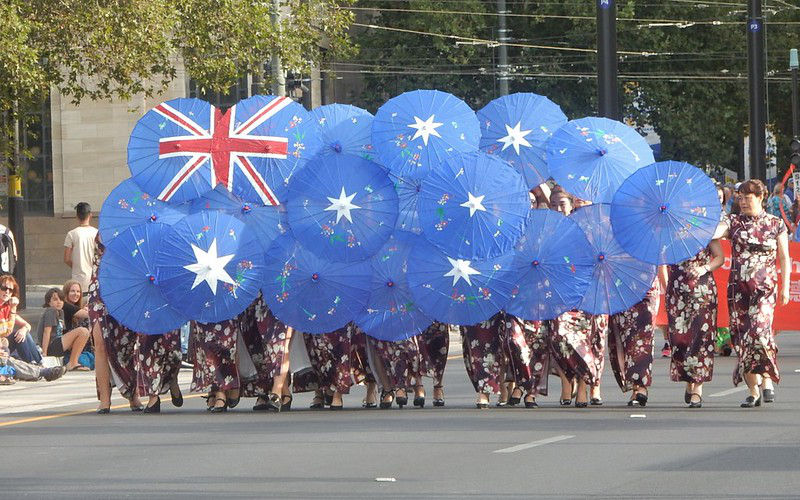Blame and frame: How Chinese Australians are counted when blamed, discounted when needed
October 17, 2025
We say we want to understand China. Then we glance past a million Chinese speakers at home and start counting somewhere else.
The Australian Financial Review and P&I recently lamented that fewer than five Australians a year graduate with honours degrees in Chinese studies, warning we’re losing the expertise to manage our most complex foreign relationship. But if that’s true, we’re not looking in the right places. The report focuses on a narrow stream of non-heritage graduates while brushing past the bilingual Australians already doing the work.
It draws a distinction — sometimes implicit, sometimes stated — between language exposure and policy relevance. Chinese-Australian citizens, residents, and international students are acknowledged, briefly, then quarantined. Their language skills are noted but doubted: not automatically “capable”.
Here’s the paradox: we have some people studying Chinese to keep university programs running and a million who speak Chinese at home. What it lacks is the willingness to count them in. The same people sustaining Chinese studies departments and our multicultural social fabric are implicitly written off as strategically unreliable.
We say we need China hands – just not those ones.
And that attitude has consequences. In her 2021 report for the Lowy Institute, Chinese Australians in the Australian Public Service, Yun Jiang found that Chinese-Australian voices remain sorely underrepresented in the very agencies tasked with foreign affairs, trade and national security. When institutions assume proximity means partiality, people stop being invited in. Then we are surprised at the talent gap.
It’s a shame that a country that prides itself on multiculturalism still draws invisible lines around whose knowledge counts. The discomfort doesn’t sit with ordinary Australians – it’s nestled in certain pockets of media, policy and commentary. The places where China is always framed as a problem and Chinese Australians always a puzzle and can’t be “objective” about China, which says more about our habits of distrust than about their citizenship.
Apparently, the only acceptable analyst is someone with no skin in the game.
What a Halloween joke.
This mistrust doesn’t stop at institutions. It spills into the way Chinese Australians are depicted — or singled out — in everyday reporting.
In Australia, there’s a subtle way to blame people without saying their names. Just point the camera. The Nine newspapers have recently run two property stories that feature large groups of Asian-Australian faces, front and centre, as illustrations of rising property prices. Neither story provided any data on buyer ethnicity. Neither offered context about who actually purchased the homes. But both sent a message, loud and clear: these are the people pricing you out.
The first incident, in July 2025, sparked a backlash on Chinese social media. A family attended an auction in Melbourne’s east, placed a bid, lost and left – only to find their image published the next day as the visual lead of a story on market heat and unaffordability. No warning. No consent. No indication they hadn’t even bought the house. Though the image was removed following the family’s protest, it had already turned them into unwilling symbols of a trend of which they weren’t part.
The second case came just last week. In a piece analysing the post-rate-cut rebound in housing prices, we see another photo in which the majority of auction attendees appear to be Asian. The article itself was about broad economic conditions: interest rates, equity, investor sentiment. Nowhere did it mention race or foreign buyers. But the photo did the rest. It suggested who’s to blame – and left the rest to the reader’s imagination.
These are not stock images from an overseas agency. They are chosen by someone here in Australia. Images like this pass through reporters, editors, producers. They’re picked not for accuracy, but for symbolism, for a “representative moment”. But when that shorthand repeatedly leans on Asian visibility in stories about scarcity and competition, it starts looking less like journalism and more like blame by framing.
And there’s no data offered to back it up. Not in July. Not now. No numbers about who bought the properties. No breakdown of domestic versus foreign buyers. Just a picture, positioned to do the heavy lifting.
It’s not that Chinese Australians are absent in the housing market – they’re buying homes. But this kind of coverage makes them hyper-visible in blame, and invisible in fairness. It singles them out visually, without backing it up analytically. And over time, it feeds public resentment – especially when paired with tabloid whispers about “foreign money” or “overseas buyers”, as we’ve seen too many times before.
Some editors will say the photos are “illustrative.” But illustrations build narratives – and once that pattern sets in, it sticks. If our media want to report seriously on housing, they should start by picking better visuals. Not ones that play into tired stereotypes, but ones that actually match the story.
Because Chinese Australians aren’t guests in this country – they’re part of the fabric. Part of the so-called sovereign capability we keep talking about. Part of the knowledge economy, the public service, the translation of values and nuance that can’t be done from a distance. And yes, part of the housing market – alongside millions of others.
Some of our media and political elites may need a gentle reminder: multiculturalism isn’t just something we clap for at footy grand finals, Chinese New Year parades, or swing through during campaign stops in Box Hill and Hurstville. It’s not a costume we wear when convenient. It’s something that either lives in our institutions – or doesn’t. And right now, from time to time, it doesn’t.
The views expressed in this article may or may not reflect those of Pearls and Irritations.
